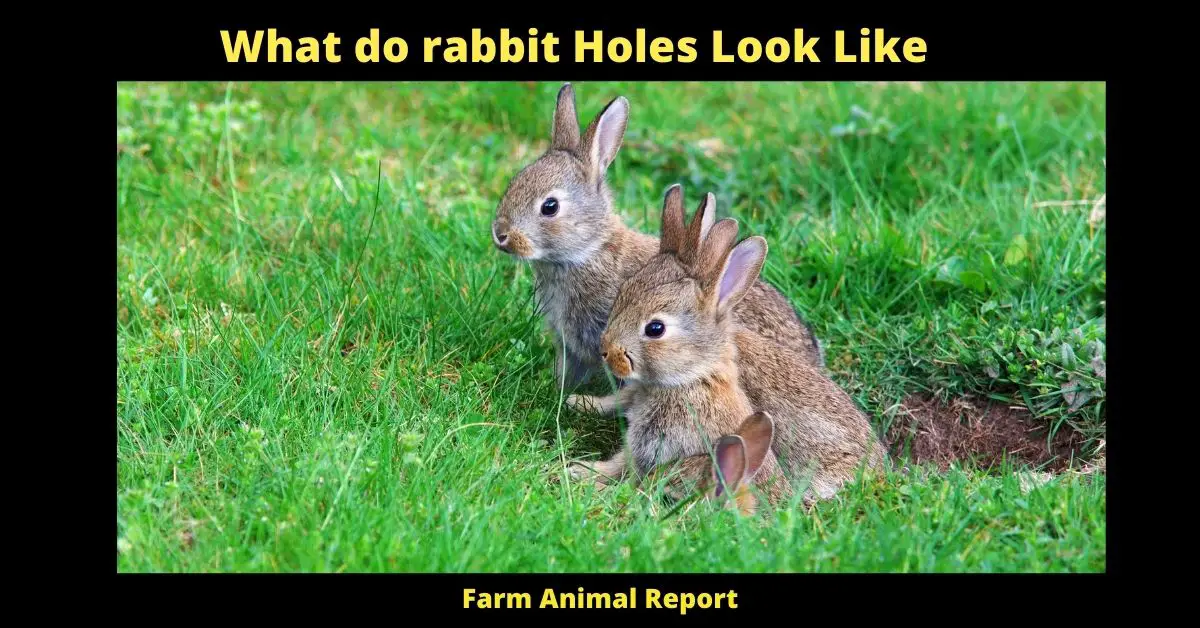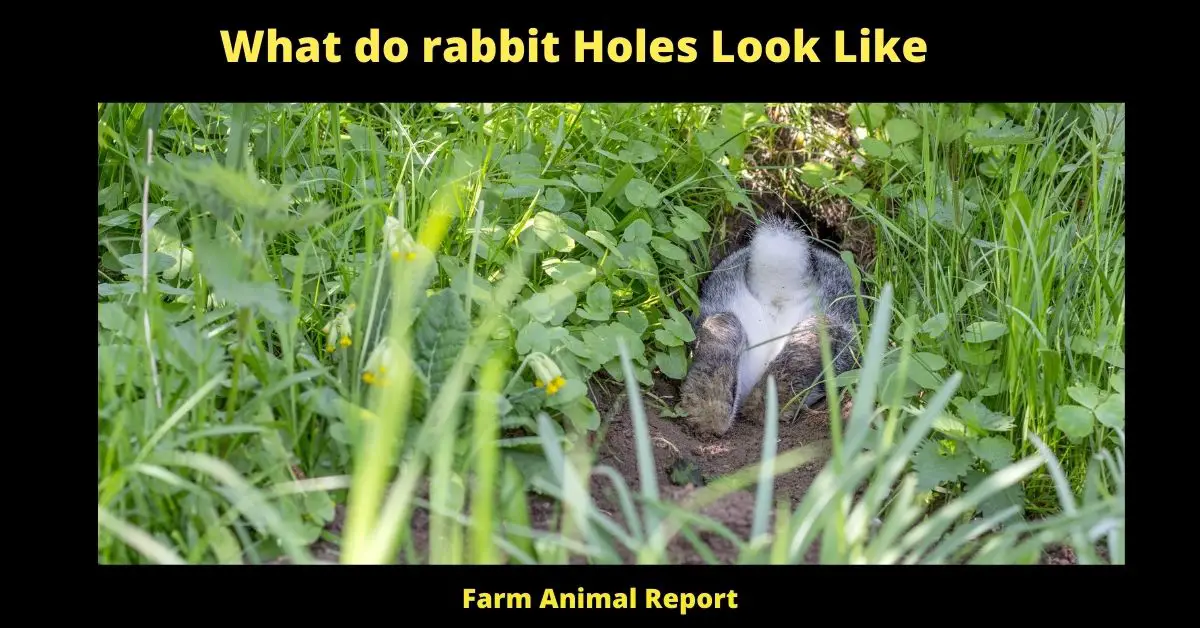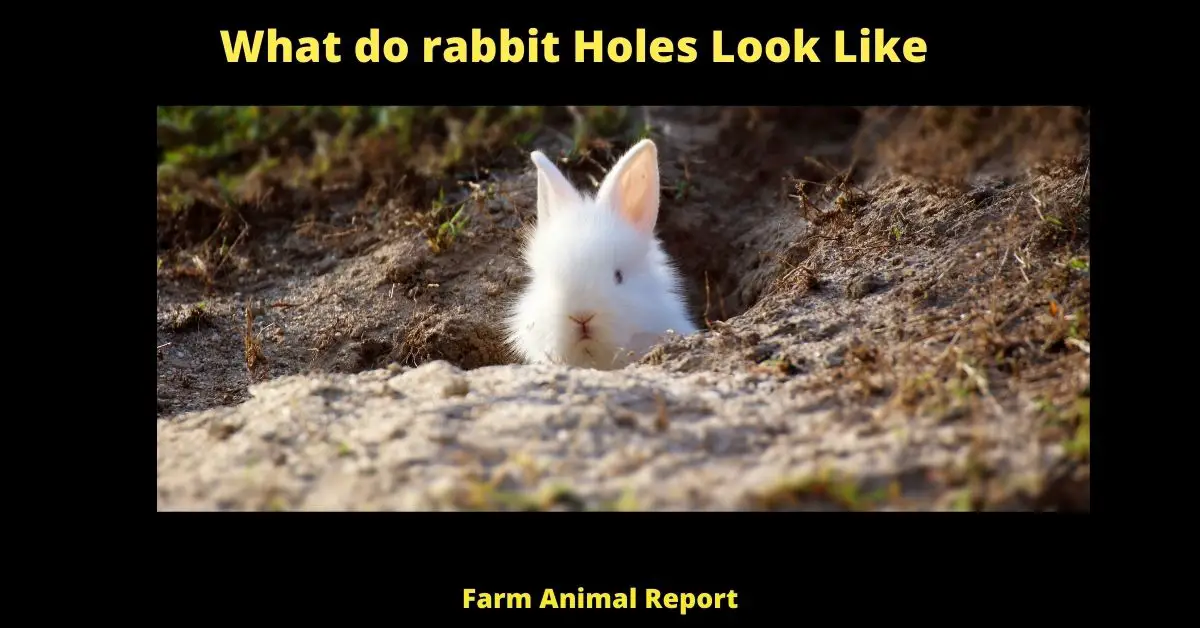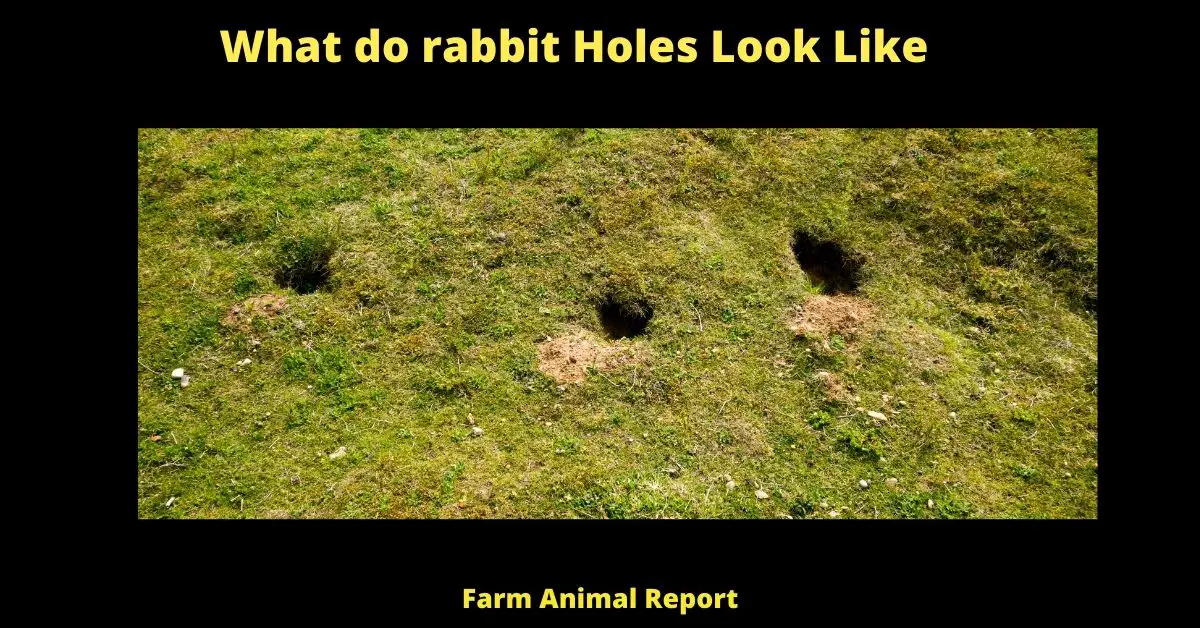What do Rabbit Holes Look Like? A Rabbit Hole looks like Rabbit burrow contains a primary entrance enclosed by a mound of soil that leads into an often complicated succession of underground chambers. There can possibly be more openings that are not surrounded by mounds. Rabbits live in groups, and their burrows can be as deep as 10 feet below the ground’s surface and as long as 150 feet in circumference.
In our childhood fantasy, we are acquainted with a rabbit’s burrow as a starting point to some mysterious place. But In reality, it’s just a hole in the ground with a few stones in it. Some of us may come across it on our property and wonder how it was dug and how it looks. Continue reading to learn everything about bunny holes.
What do a Rabbit Holes Look Like?
Rabbit burrows, also known as rabbit holes, contain a primary entrance enclosed by a mound of soil that leads into an often complicated succession of underground chambers. There can possibly be more openings that are not surrounded by mounds. Rabbits live in groups, and their burrows can be as deep as 10 feet below the ground’s surface and as long as 150 feet in circumference. What do a Rabbit Holes Look Like?
Depending on the species, the dwelling compartments within the hole can reach as high as one to two feet in height. A warren is a collection of rabbit tunnels that have been grouped together. More than 45% of the world’s rabbits live in North America, which is home to a diverse range of species.

Rabbits may be found in various habitats, including woods, forests, pastures, marshes, deserts, and meadows. The European rabbit, Oryctolagus cuniculus, loves dry, soft soil, making digging simpler. Animals such as rabbits have adapted to coexist with human populations and may be found roaming freely in city parks and lawns as well as gardens and cemeteries. Jump to 18 Ways to Make Money by Rabbit Farming **CHARTS**
Rabbits are herbivores that are primarily active at night. They leave their holes at night to look for food, and they return in the early morning hours to do the same.
Check Out Amazons Pet Rabbit Supplies
Given the fact that they are prey species and are pursued by foxes, beavers, and other larger creatures, they are particularly sensitive to their environment. Burrowing is one of the methods they use to try to escape being eaten by predators. They also have a 360-degree range of vision and, like other prey animals, will sleep with their eyes open. What do rabbit Holes Look Like
Why do rabbits dig holes? (Burrows)
They dig holes mostly as a result of their innate instinctive activity. It is in their genetic makeup to behave in this manner. There are various reasons why rabbits dig, including locating food, exposing cold soil to rest on, attempting to escape, or attempting to draw attention.
Rabbits dwell in burrows in the wild, and they eat grass. A warren is a collection of burrows that are connected to one another and where a rabbit colony may be found.
How Deep are They? (Wild Rabbits Digging)
Rabbit Holes may reach depths of about 10 feet below ground and span distances of nearly 150 feet on average (as mentioned above).
However, not all rabbit holes are created equal – they vary in depth, circumference, and size depending on various conditions, including environment and species type.
Furthermore, because rabbits are gregarious creatures, the majority of them build their burrows in a grouping of three or more. The holes are referred to as tunnels, and they may be found in various locations.
Depth of hole usually depends upon two factors:
1. Breed/Species ( Female Rabbits Dig)
- Cottontail — They are not well-known for their digging habits. Instead, they would most likely take up residence in abandoned burrows left by others.
- Pygmy- In contrary to cottontail, they are heavy borrowers.
- Hares – They do not engage in the act of ‘digging a hole,’ nor do they exhibit this behavior. In order to cover for this, they create cavities in the grass. These are sometimes referred to as “forms.”
Having said that, it is difficult to determine the typical depth of a burrow since there is no such thing as a standard/optimum depth. The rabbit’s urge to dig a hole is determined by the variables listed above, as well as its need to feel secure.
However, if you want to ensure that the rabbit does not leave or enter your property, it is preferable to install a fence that is 6 to 10 inches deep in the ground, with a few inches buried laterally to prevent the small critters from tunneling beneath it.

2. Location
The greater the ease with which the soil may be dug, the deeper the hole. As the rabbit’s increasing family is responsible for its existence and establishment, the duration of time can also be taken into consideration.
The depth varies according to the water level. The bunnies take into consideration the water level because the average depth is affected in such severe situations as high water and low water.
What does the inside of a rabbit hole look like?
From inside, rabbit holes have a normal ground hole look, but sometimes, when they store food or care for their young ones, their hole is filled with stuff.
Why are rabbit Holes dangerous on the Farm? ( Rabbits Love Digging)
It is risky to leave rabbit tunnels unchecked on the Farm because if the ground beneath a burrow system is allowed to deteriorate over time, it will collapse. This is particularly dangerous if the Farm is located near highways, trains, or buildings, as it will weaken the structural stability of these buildings. They also pollute the soil with their urine and droppings, allowing only weeds to survive, which is detrimental to farmers’ livelihoods and crops.
Here are some more issues that farmers and other people are dealing with due to rabbits.
1. Decreased crop yield
Bunnies are a major problem for farmers, and they require continual management to ensure that numbers do not go out of control. Seven rabbits can consume the same amount of food as a sheep, given their tendency to reproduce fast. It is easy to see how they may significantly influence a farmer’s agricultural productivity in a short period of time.
2. Killing plants and removing flower heads
Blooming gardens resplendent in color are the preferred prey of many rabbits, who opt to de-head flowers and ingest plant shoots, bringing them all the way back to ground level. They may completely demolish a garden in a matter of days, turning your summer background into a desolate patch of earth.

3. Damage to the lawn
Raised beds of rabbit droppings and urine can leave scorch marks on formerly lush green lawns, and their burrows will produce the illusion of potholes. They are the nemesis of many athletic grounds because they can cover large areas without being disturbed and are difficult to regulate when there is a large amount of general public involvement.
In addition to the ugly look of rabbit warrens, landowners are concerned about the influence of rabbit warrens on their business’s health and safety, as well as the possibility of injured parties filing lawsuits against them.
4. Damage to trees
Rabbits may damage orchards and forestry plantations. A protective covering is removed from trees by rabbits as they peel their bark, allowing for the growth of fungus and bacteria that eventually cause the trees to die due to a lack of nutrients.
A big rabbit population may devastate whole hectares of new plantations in a very short period of time, especially in younger plantations. This means that the landowner’s investment has been squandered, and any anticipated money has been lost.
How to Avoid Having Rabbit Holes in Your Surroundings? (Stop Rabbits Digging)
A rabbit is a tiny small animal, yet it can wreak significant damage to your landscape when it gets out of control. According to experts’ observations, rabbits would most likely graze on the freshly developing plants you have been caring for over the previous few years. Because they are a significant nuisance in this situation, the following are some recommendations for getting rid of rabbits in your yard.
1. Recognize Their Presence
They are hard to monitor actively, yet they are visible even in the early hours of the morning. Rabbit droppings that are the same size as a pea and are dispersed over the area should be avoided at all costs.
Check your plant to check if any stalks or leaves have fallen off and if so, prune them back to their original positions. Because of the sharpness of the rabbit’s teeth, the leaf appears to have been sliced cleanly.
2. Adopt a dog and keep it on the leash outside.
Rabbits are easily frightened, which implies that the presence of a dog would very certainly cause them to flee.
3. Reduce the appeal of your yard.
Mow the long grasses in your yard, block the entry beneath some of the little buildings in your home, and logically arrange the pile of leaves.
These are possible observations that may be utilized as a hiding place from predators, and they would almost certainly attract the fuzzy critters to your yard. Also, provide some plants that the rabbit would never consume in your garden. Marigolds, Mexican sunflowers, vinca, and cardinal flowers are examples of such flowers.
4. Place barriers around your plants to prevent them from being harmed.
Build a fence around your garden to keep out the animals. Because rabbits are known to be heavy diggers, they are recommended to be buried with at least six feet of soil or more. Allow for additional height in the fence, with at least three feet added for additional stability. You might even choose to add an electrified fence if you so choose.
How Large are Rabbit Holes?
Any farmer worth his salt knows that rabbits can be a real nuisance. Not only do they munch on crops, but they also burrow underground, causing all sorts of problems. But just how large are these holes?
The average rabbit hole is about 4 inches in diameter and up to 2 feet deep. However, some rabbits will dig much larger holes, especially if they’re looking to make a home for their young. In fact, one particularly enterprising rabbit was even able to tunnel under a fence and escape from a farm!
While rabbits may be cute, their holes can cause all sorts of problems. That’s why it’s important to be aware of just how large these little creatures can dig.
How Deep are Rabbit Holes?
If you’ve ever had a gardening project ruined by pesky rabbits, you might have wondered just how deep their holes can be. While every rabbit hole is different, they all have one thing in common: they’re deeper than you might think
. A rabbit’s burrow can extend six feet underground and span up to 30 feet in length. The main tunnel is typically around two feet wide, but it can be as large as four feet in diameter. A rabbit hole usually has multiple entrances and exits, and it is often lined with soft materials like grass or fur to keep the rabbits warm and comfortable.
Do Rabbit Holes have two Entrances?
Many people believe that rabbit holes have two entrances, but this is not always the case. The size and shape of a rabbit hole will vary depending on the type of soil and the amount of traffic in the area.
In some cases, a rabbit hole may only have one entrance, while in others there may be multiple entrances and exits. However, the most common type of rabbit hole is the burrow, which typically has two entrances.
The main entrance is used for coming and going, while the second entrance is used as an escape route in case of predators. Either way, it’s important to be careful when walking near rabbit holes, as you never know what might be lurking inside.
Unique Facts about Rabbit Holes
- Rabbit holes can lead to a variety of different places, including a secret garden, an underground laboratory, or even a magical kingdom.
- Rabbits are the only mammal that can survive in a burrow, as they are well-adapted to living in holes.
- Rabbit holes are often used by rabbits as a place for protection from predators.
- The first recorded use of the phrase “rabbit hole” was in Alice’s Adventures in Wonderland, written by Lewis Carroll in 1865.
- Rabbit holes can be quite deep, reaching up to 3 feet in depth.
- Rabbits have a special type of fur that helps them to stay warm in their burrows and a special organ that helps them to sense predators nearby.
- Rabbits have extremely powerful legs, which helps them to dig and construct their burrows.
- Rabbit holes provide a safe place for rabbits to sleep, raise their young, and even mate.
- Rabbit holes are often used as a form of camouflage, as they blend in with their surroundings.
- Rabbits have an incredible sense of smell, which helps them to determine if a predator is nearby.
Other Important Tags
- rabbits digging holes
- wild rabbits digging
- female rabbits dig
- pet rabbit digging
- rabbits love digging
- stop rabbits digging
- wild rabbits dig
- rabbits dig holes
Final Thoughts – What does a Rabbit Hole Look Like?
Rabbit burrows contain a primary entrance enclosed by a mound of soil that leads into an often complicated succession of underground chambers. There can possibly be more openings that are not surrounded by mounds. Rabbits live in groups, and their burrows can be as deep as 10 feet below the ground’s surface and as long as 150 feet in circumference.





